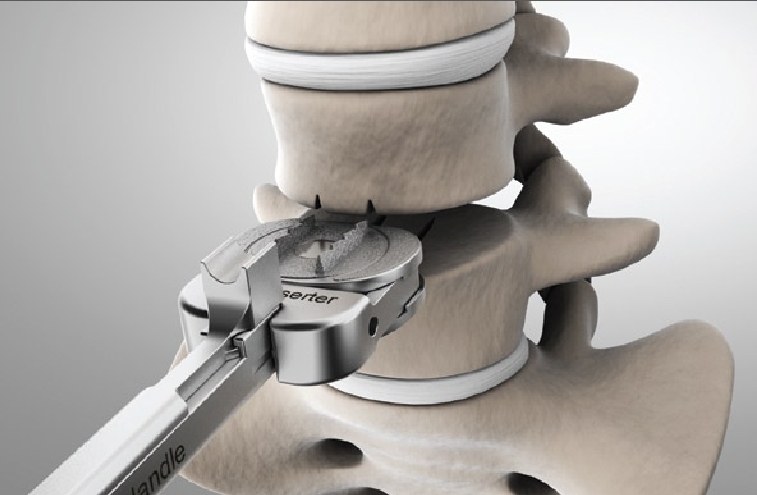. 2022 Jan 12;2022:2690291.
doi: 10.1155/2022/2690291.
eCollection 2022.
Affiliations
Affiliation
- 1 Departmen of Orthopedics, Capital Medical University Affiliated Beijing Chaoyang Hospital, Capital Medical University, No. 8 Gongtinanlu, Beijing 100020, China.
Item in Clipboard
Yue Li et al.
Pain Res Manag.
.
Display options
Format
. 2022 Jan 12;2022:2690291.
doi: 10.1155/2022/2690291.
eCollection 2022.
Affiliation
- 1 Departmen of Orthopedics, Capital Medical University Affiliated Beijing Chaoyang Hospital, Capital Medical University, No. 8 Gongtinanlu, Beijing 100020, China.
Item in Clipboard
Display options
Format
Abstract
In this prospective cohort study, we aimed to determine the surgical and adjacent segment changes in paraspinal muscles and facet joints in patients with lumbar spinal stenosis after minimally invasive posterior lumbar interbody fusion (PLIF) using the cortical bone trajectory (CBT) technique. We enrolled 30 consecutive patients who underwent the single-level CBT technique between October 2017 and October 2018. We evaluated preoperative and 1-month, 3-month, 6-month, and 1-year postoperative clinical data including Visual Analogue Scale (VAS) scores and Oswestry Disability Index (ODI). Magnetic resonance imaging (MRI) was performed a year after surgery. The erector spinae (ES) muscle area, volume, and fat infiltration (FI) on the surgical and adjacent segments were evaluated using the thresholding method, and the degree of adjacent facet joint degeneration was calculated using the Weishaupt scale. FI rate was graded using the Kjaer method. All patients underwent a 12-month follow-up. The VAS and ODI scores significantly improved after surgery in all patients. No patient showed degeneration of the adjacent facet joints (P > 0.05) during the 1-year follow-up postoperation. There was no significant difference in ES muscle volume, area, and FI on the surgical and adjacent segments (P > 0.05). The FI rate of the upper ES muscles increased postoperatively (P < 0.05); however, there were no significant changes in FI rate of the lower ES muscles. Patients with lumbar spinal stenosis could obtain satisfactory short-term clinical outcomes via minimally invasive PLIF using the CBT technique. Moreover, this technique may reduce the impact on the paravertebral muscles, especially the ES muscle, and the adjacent facet joints.
Copyright © 2022 Yue Li et al.
Conflict of interest statement
The authors declare that there are no conflicts of interest regarding the publication of this paper.
Figures

Figure 1
A 45-year-old male patient diagnosed…
Figure 1
A 45-year-old male patient diagnosed with lumbar spinal stenosis. (a) represents L4-L5 vertebral…
Figure 1
A 45-year-old male patient diagnosed with lumbar spinal stenosis. (a) represents L4-L5 vertebral MRI, while (b) is the same image obtained after processing by the ImageJ software. (c) represents L4-L5 vertebral MRI after CBT surgery, while (d) is the same image obtained after processing by the ImageJ software. The area enclosed by the yellow line after image thresholding in the ImageJ software is the ES portion of the paravertebral muscle. ES area and FI obtained by calculation using the ImageJ software.

Figure 2
To estimate the volume, the…
Figure 2
To estimate the volume, the entire ES muscle is considered as a circular…
Figure 2
To estimate the volume, the entire ES muscle is considered as a circular table. The areas of the upper and lower segments are A and B, respectively. Using the height h between the upper and lower segments, the volume of the ES is estimated using the formula
.

Figure 3
Preoperative and 1-year postoperative Weishaupt…
Figure 3
Preoperative and 1-year postoperative Weishaupt scale scores of the upper segment facet joints.…
Figure 3
Preoperative and 1-year postoperative Weishaupt scale scores of the upper segment facet joints. USFJ, upper segment facet joints.

Figure 4
Preoperative and 1-year postoperative Weishaupt…
Figure 4
Preoperative and 1-year postoperative Weishaupt scale scores of the lower segment facet joints.…
Figure 4
Preoperative and 1-year postoperative Weishaupt scale scores of the lower segment facet joints. LSFJ, lower segment facet joints.
References
-
-
Chen X., Hodges P. W., James G., Diwan A. D. Do markers of inflammation and/or muscle regeneration in lumbar multifidus muscle and fat differ between individuals with good or poor outcome following microdiscectomy for lumbar disc herniation? Spine . 2021;46(10):678–686.
–
PubMed
-
Cite

